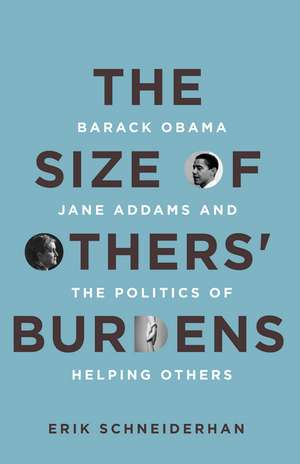The Size of Others' Burdens: Barack Obama, Jane Addams, and the Politics of Helping Others
Autor Erik Schneiderhanen Limba Engleză Hardback – 26 mai 2015
Although Jane Addams and Barack Obama are separated by roughly one hundred years, the parallels between their lives are remarkable: Chicago activists-turned-politicians, University of Chicago lecturers, gifted orators, crusaders against discrimination, winners of the Nobel Peace Prize. Addams was the founder of Hull-House, the celebrated American "settlement house" that became the foundation of modern social work. Obama's remarkable rise to the presidency is well known.
Through the stories of Addams's and Obama's early community work, Erik Schneiderhan challenges readers to think about how many of our own struggles are not simply personal challenges, but also social challenges. How do we help others when so much of our day-to-day life is geared toward looking out for ourselves, whether at work or at home? Not everyone can run for president or win a Nobel Prize, but we can help others without sacrificing their dignity or our principles. Great thinkers of the past and present can give us the motivation; Addams and Obama show us how. Schneiderhan highlights the value of combining today's state resources with the innovation and flexibility of Addams's time to encourage community building. Offering a call to action, this book inspires readers to address their own American dilemma and connect to community, starting within our own neighborhoods.
Preț: 152.41 lei
Nou
29.17€ • 30.27$ • 24.38£
Carte disponibilă
Livrare economică 24 februarie-10 martie
Specificații
ISBN-10: 0804789177
Pagini: 264
Dimensiuni: 140 x 216 x 25 mm
Greutate: 0.43 kg
Editura: Stanford University Press
Colecția Stanford University Press
Recenzii
"The lives of Jane Addams and Barack Obama show how great achievements may come from grappling with ambivalence, not from crystalline clarity. A lesson of particular importance for those who work to bring change within a profoundly unequal society, it is nowhere more true than in navigating the American dilemma where poverty and racism coexist in a society of plenty and partial freedoms. The Size of Others' Burdens deserves to be widely read."—Craig Calhoun, President, London School of Economics and Political Science
Notă biografică
Cuprins
This chapter presents an overview of the book's main premise: that the struggle between promoting individual responsibility and helping others in the community has been a hallmark of American culture. It introduces the two main empirical subjects of the book¿Jane Addams and Barack Obamäand paints in broad brushstrokes their shared successes and struggles as they tried to do community work in Chicago.
This chapter looks at the early life of Jane Addams before she founded Hull-House. It shows how her cultivation of privilege, her extensive travel, and her college education all contributed to her constructing a social self that did not conform to traditional gender norms. The chapter also sets the stage in Chicago by developing a portrait of existing charity organizations and showing how Addams and her friend Ellen Gates Starr launched a new and different way of helping others at Hull-House.
This chapter starts with the opening of Hull-House in 1889 and goes on to illuminate some of the key successes and struggles of Jane Addams as she tried to help her neighbors in the Nineteenth Ward of Chicago. It shows how Addams's independent and creative work shifted in the early 1890s to include charity organization methods, a more hard-nosed approach to helping others.
This chapter begins in 1894, with Jane Addams struggling to meet the needs of the seemingly endless number of neighbors requiring her help. Hull-House did not have the capacity to address the needs of the city so Addams helped found the Chicago Bureau of Charities (CBC). Her work on behalf of the CBC is contrasted with her efforts at Hull-House, emphasizing her dilemmas as she tried to adjudicate between two very different approaches to helping others. The chapter also chronicles Addams's increasing involvement with Chicago elites, as she entered into politics and needed to raise funds to support her charitable work. It concludes with a brief summary of the three Addams chapters.
This chapter looks at the early life of Barack Obama. It shows how his childhood in Indonesia and Hawaii, his elite education, and his extensive travel contributed to his constructing a social self and line of action that did not conform to traditional social expectations. The chapter illuminates Obama's struggles with the dilemma of making a difference in the world versus making a living. It concludes by tracing his trajectory from New York to Chicago, where he would begin his community organizing with the Developing Communities Project.
In this chapter, the Chicago community work of Barack Obama is presented. The chapter shows how his creativity and experimentalism helped the Developing Communities Project make a difference in people's lives. It also shows how Obama's efforts were stymied, illuminating his struggles to empower community members with limited resources. It concludes with Obama's decision to leave Chicago and attend Harvard Law School so that he might make a difference on a larger scale.
This chapter spans several years in Obama's life¿from his time at Harvard to his return to Chicago as a political organizer at Project Vote! and his experiences as a lawyer and University of Chicago lecturer. It shows his efforts to balance his own individual goals with his desire to make a difference in Chicago. And it shows how his new wife Michelle contributed to the development of connections to Chicago elites, connections that proved helpful as Obama decided to run for the Illinois State Senate. The chapter concludes with a brief summary of the main ideas of the three Obama chapters.
This chapter begins with a précis, briefly highlighting some key points of the biographies of Addams and Obama after the time period examined in the book. The chapter then returns to the theme of the American's Dilemma, illustrating how Addams and Obama dealt with their everyday struggles to balance their individual and collective goals. The chapter concludes with a discussion of how the examples of Addams and Obama might inform our own efforts to move beyond our own social dilemmas and contribute to community growth.
The appendix, more academic in tone, discusses the primary and secondary sources for the data on Addams and Obama. It then moves on to a presentation of the main theory underpinning the book's analysis, including ideas from Sartre, Merton, Lynd, Dewey, and Sumner, to name but a few.

























